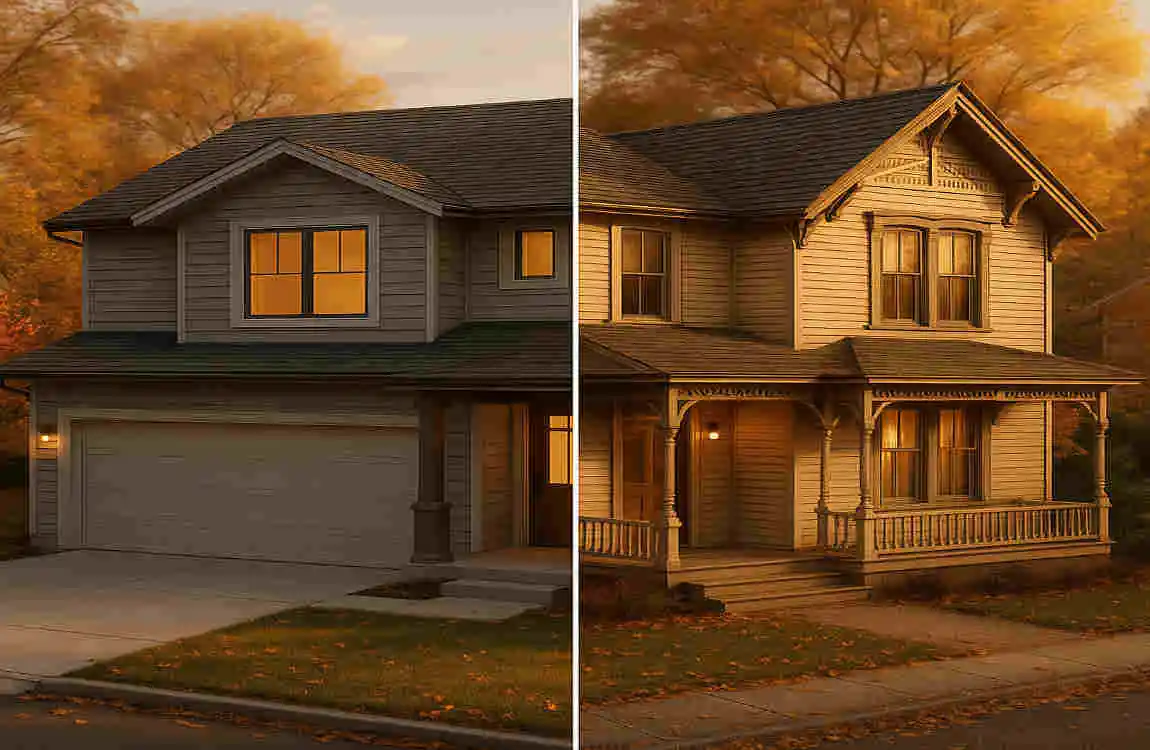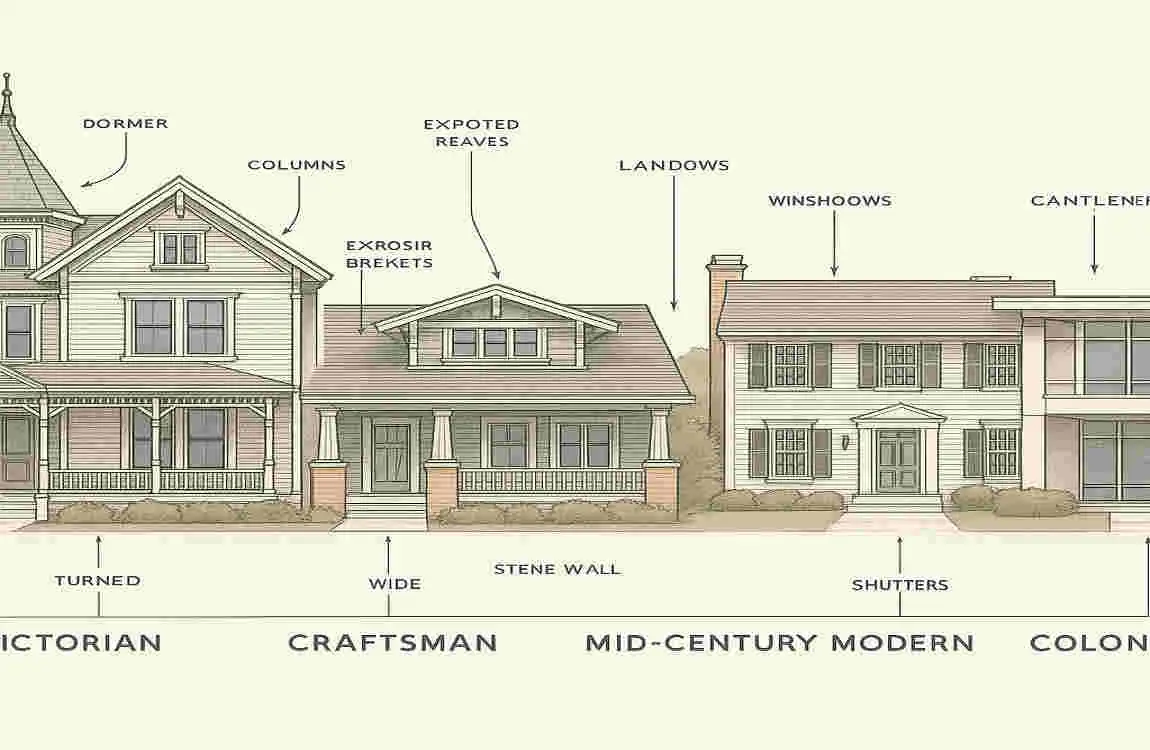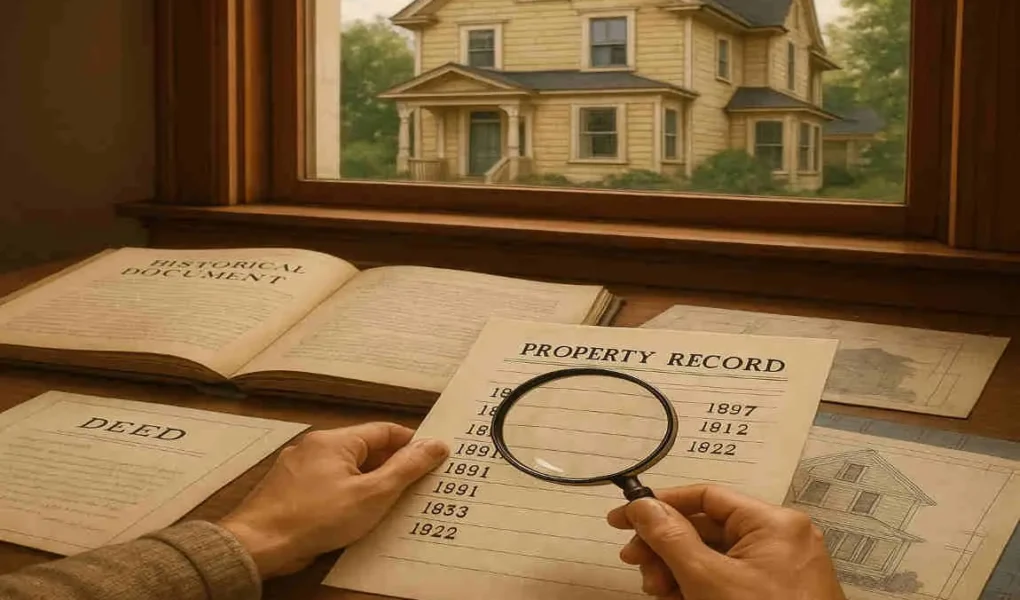Have you ever walked through your home and wondered about its history? Knowing when your house was built isn’t just about satisfying curiosity—it’s a crucial piece of information that can impact everything from your insurance rates to your renovation plans. If you’ve been asking yourself, “What year was my house built in?” you’re in the right place.
Understanding your home’s age unlocks opportunities for informed maintenance decisions, innovative renovations, and even potential tax benefits. Whether you’re a new homeowner or you’ve lived in your house for years, discovering its construction date can be surprisingly rewarding. Plus, there’s something magical about knowing the stories your walls could tell.
Why Find Out the Year Your House Was Built?

Impact on Property Value and Resale
The age of your home directly influences its market value. Older homes with historical significance often command premium prices in specific neighborhoods. Buyers love homes with character, and knowing your house’s exact age helps you market these unique features effectively.
Real estate agents frequently use home construction dates to compare similar properties. When you know your home’s age, you can better understand its position in the local market. This knowledge becomes invaluable during appraisals and negotiations.
Helps with Home Maintenance and Repairs
Different eras used different building materials and techniques. A house built in the 1920s might have plaster walls, while one from the 1970s likely features drywall. Understanding your home’s age helps you anticipate maintenance needs and budget accordingly.
Older homes often require specific repair approaches. Knowing your house’s age helps contractors provide more accurate estimates and use appropriate restoration methods. You’ll avoid costly mistakes that come from treating vintage materials with modern techniques.
Essential for Historical and Architectural Interest
Many homeowners discover their properties have fascinating histories. Your 1890s farmhouse might be eligible for historical designation, bringing tax credits and community recognition. Even newer homes can have interesting stories—perhaps yours was built by a notable local developer or represents a significant architectural movement.
Historical societies often maintain archives about local properties. Once you know your home’s age, you can dig deeper into its past owners, original purpose, and role in your community’s development.
Planning Renovations Based on Building Codes
Building codes have evolved dramatically over the decades. A home built in 1950 follows very different standards from one built in 2000. Understanding these differences helps you plan renovations that respect your home’s original structure while meeting current safety requirements.
Contractors need this information to pull proper permits. Some renovations on older homes trigger requirements to bring entire systems up to current code. Knowing your home’s age helps you budget for these potential surprises.
Insurance Considerations
Insurance companies factor your home’s age into premium calculations. Older homes might face higher rates due to outdated electrical or plumbing systems. However, recent renovations can offset these concerns if properly documented.
Some insurers offer specialized policies for historic homes. These policies recognize the unique value of period-appropriate materials and craftsmanship. Without knowing your home’s age, you might miss out on coverage that better protects your investment.
Standard Methods to Discover the Year Your House Was Built
Using Public Property Records and Tax Assessor Data
Your local tax assessor’s office maintains comprehensive records about every property in its jurisdiction. These records typically include the construction year, though accuracy varies by location. Many counties now offer online access to this information, making research convenient from your couch.
Start by visiting your county assessor’s website. Look for a property search function—you’ll usually need your address or parcel number. The resulting report often shows the “year built” or “effective year built” along with other property details.
You may also read (what are the different types of home construction).
If online access isn’t available, visit the assessor’s office in person. Staff members can help you navigate their records. Bring your property address and any ownership documents to speed up the process.
Checking the Deed or Title Documents
Your property deed contains valuable historical information. While deeds don’t always list construction dates, they show ownership transfers that can narrow down when your house was built. A deed showing farmland in 1920 and a residential property in 1925 suggests construction happened between those dates.
Title companies maintain chains of ownership going back decades or centuries. If you purchased title insurance, your policy packet might include historical deed information. Contact your title company for a complete ownership history—many provide this service for a small fee.
Review your closing documents carefully. The title report prepared for your purchase often includes notes about the property’s history, including construction dates found during their research.
Reviewing Original Building Permits and Plans
Building departments keep permit records for new construction, major renovations, and additions. These documents provide the most accurate construction dates, often down to the exact day work began. Many cities have digitized older permits, making them searchable online.
Visit your local building department’s website first. Look for permit search tools where you can enter your address. Even if original construction permits aren’t online, you might find renovation permits that reference the original construction date.
For older homes, physical permit records might be stored in archives. Building department staff can guide you to these resources. Some cities have transferred historical permits to local libraries or historical societies for preservation.
Asking Real Estate Agents or Previous Owners
Your real estate agent likely researched your home’s history during the sales process. They might have MLS records showing construction dates from previous listings. Good agents keep files on properties they’ve sold—reach out even if your purchase was years ago.
Previous owners often know details not found in official records. If you have their contact information, a friendly email or letter might yield valuable insights. They might share stories about the home’s construction or renovations that help pinpoint its age.
Neighbors, especially longtime residents, can be goldmines of information. That elderly couple next door might remember when your house was built or have photos showing your lot before construction.
Inspecting Physical Clues in the Home
Your house itself provides numerous indicators of its age. Architectural details, construction methods, and materials all point to specific time periods. Learning to read these clues turns you into a house detective.
Look for date stamps on fixtures and materials. Toilets, water heaters, and electrical panels often display manufacturer dates. While these might indicate renovations rather than original construction, they provide useful timeline markers.
Foundation styles, framing techniques, and even nail types indicate construction eras. Hand-forged square nails suggest pre-1890s construction, while wire nails became standard afterward. These details help confirm or question official records.
Online Tools and Resources for Identifying Your Home’s Age
Popular Real Estate Websites
Zillow has become many homeowners’ first stop for property information. Their database pulls from public records and past listings to display “Year Built” information. While generally accurate, always verify with official sources.
Realtor.com offers similar functionality with potentially different data sources. Comparing information across multiple sites helps identify discrepancies worth investigating. These platforms often include historical listing photos showing your home’s evolution.
Redfin provides detailed property histories, including past sale prices and dates. Their data sometimes includes notes from previous listings mentioning construction dates or significant renovations. Create a free account to access complete historical information.
Local Government Databases
Most counties now offer online GIS (Geographic Information Systems) mapping tools. These interactive maps let you click on your property to see assessment data, including construction years. They’re often more current than third-party websites.
City websites frequently provide property information portals. These might be separate from county systems and contain different details. Building permit databases, code violation records, and utility connection dates all provide construction date clues.
State-level databases sometimes aggregate local information. Check your state’s revenue or taxation department website for property search tools. These can be particularly helpful if you’re researching properties across county lines.
Specialized History and Genealogy Sites
Ancestry.com and similar platforms offer historical city directories and maps. These resources show when addresses first appeared and who lived there. A home appearing in the 1935 directory but not the 1930 suggests construction between those years.
Local historical society websites often feature property databases or vintage photograph collections. These resources provide context about neighborhood development and might include construction timelines for entire subdivisions.
Newspaper archives contain building announcements and real estate advertisements. Many libraries provide free digital access to historical newspapers. Search for your address or neighborhood name to find construction-era articles.
Free vs. Paid Resources
Free resources typically include basic property data from public records. County assessor sites, Zillow, and many historical societies offer valuable information without charge. Start with these options before paying for specialized services.
Paid services provide deeper historical research and consolidated reports. Companies like BuildingHistory.com or HouseHistoryReport.com compile data from multiple sources. These reports cost $20-100 but save hours of research time.
Consider paid options if free resources yield conflicting information or you need documentation for legal purposes. Professional house historians can provide detailed reports suitable for historical designation applications or insurance claims.
Understanding Property Records and What They Tell You

Types of Information in Property Records
Tax assessment records show more than just “year built” data. They typically include square footage, lot size, number of rooms, and construction type. This information helps verify the year built by confirming your house matches historical descriptions.
Building permits reveal construction timelines and contractor information. Original permits show who built your house and when. Subsequent permits track major renovations that might affect the “effective age” used for tax purposes.
Deed records provide ownership chains and property descriptions. While they rarely state construction dates directly, they show when properties changed from vacant land to improved property. This transition usually indicates construction timing.
Interpreting Different Record Types
Tax records use “year built” for assessment purposes. This date might reflect major renovations rather than original construction. If your 1920s home was gutted and rebuilt in 1980, tax records might show 1980 as the year built.
Building permits offer the most accurate construction dates, but might be incomplete. Historically, not all jurisdictions required permits, and fires or floods destroyed some records. Multiple permits might exist if construction occurred in phases.
Title documents focus on ownership rather than structures. However, mortgage records often describe improvements on the property. A 1925 mortgage for “vacant land” followed by a 1926 mortgage for “house and lot” pinpoints construction timing.
Accuracy and Limitations
Public records contain errors, especially for older properties. Transcription mistakes, estimation, and lost documents all affect accuracy. Always verify important dates through multiple sources.
Record-keeping standards varied historically. Rural areas might have minimal records before specific dates. Urban areas typically maintained better records but faced challenges, such as fires destroying city halls and their archives.
Updates to records don’t always happen promptly. Major renovations might not appear in tax records for years. Recent construction may not be reflected in online databases that are updated annually or less frequently.
How Architectural Styles and Features Help Identify Your Home’s Age
Victorian Era (1840s-1910s)
Victorian homes showcase ornate details and asymmetrical designs. Look for decorative trim, bay windows, and complex rooflines. These homes often feature tall, narrow windows and elaborate porches with spindle work.
Interior clues include high ceilings, crown molding, and pocket doors. Original Victorian homes often feature plaster walls and may still retain gas light fixtures that have been converted to electricity. Hardwood floors typically show square-edged boards rather than modern tongue-and-groove construction.
Foundation materials provide dating clues. Stone or brick foundations suggest earlier Victorian construction, while concrete became common after 1900. Check your basement for construction techniques matching this era.
Craftsman Style (1905-1930s)
Craftsman homes emphasize horizontal lines and natural materials. Low-pitched roofs with wide eaves, exposed rafters, and front porches with tapered columns define this style. Built-in furniture and woodwork showcase the era’s emphasis on craftsmanship and skill.
Interior features include built-in bookcases, window seats, and dining room buffets. Wood trim remains substantial but straightforward, often featuring flat boards rather than ornate moldings. Original Craftsman homes have plaster walls and wood floors throughout.
Look for specific hardware and fixtures. Craftsman homes often retain original push-button light switches and two-prong electrical outlets. These details help date homes to the 1910s and 1920s, before modern electrical standards were established.
Mid-Century Modern (1945-1970s)
Post-war homes embraced open floor plans and connections to the outdoors. Look for large windows, sliding glass doors, and minimal ornamentation. Flat or low-pitched roofs and integration with landscape design mark this era.
Interior indicators include original terrazzo or linoleum flooring, wood paneling, and pass-through windows between kitchens and dining areas. Post-and-beam construction might be visible, celebrating structural elements as design features.
Mechanical systems provide dating evidence. Forced-air heating became standard, replacing radiators. Original electrical panels might show fuse boxes transitioning to circuit breakers during this period.
Ranch Style (1950s-1980s)
Ranch homes stretch horizontally with single-story layouts. Attached garages, picture windows, and minimal exterior decoration define the style. These practical homes reflect the suburban expansion and automobile culture of the era.
Interior layouts emphasize casual living. Look for L-shaped or U-shaped floor plans, sliding closet doors, and connections between indoor and outdoor spaces. Original features include knotty pine paneling and brick fireplaces.
Construction techniques evolved during the ranch era. Earlier examples use plaster walls, while later ones feature drywall. Aluminum windows replaced wood during the 1960s, helping narrow construction dates.
Contemporary Styles (1980s-Present)
Modern homes incorporate diverse influences and energy-efficient features. Vaulted ceilings, great rooms, and master suites became standard. Look for features like skylights, multi-car garages, and extensive use of manufactured materials.
Kitchen and bathroom designs provide dating clues. Granite countertops suggest post-2000 construction, while laminate indicates earlier decades. Original appliances and fixtures often include date stamps, helping to pinpoint the construction years.
Building codes and standards help date contemporary homes. Energy-efficient windows, modern insulation standards, and updated electrical requirements all correspond to specific time periods. These technical details provide accurate dating for newer construction.
When Records Are Incomplete or Unavailable
Estimating Age Without Documents
Sometimes official records disappear or never existed. Rural properties and homes built before mandatory permitting face this challenge. Don’t worry—several techniques help estimate construction dates without paperwork.
Start with architectural analysis. Construction methods evolved predictably over time. Hand-hewn beams suggest pre-1850s construction, while circular saw marks indicate post-1850s building. Nail types, mortar composition, and framing techniques all provide chronological clues.
Research your neighborhood’s development, even without specific house records, subdivision plats, and area histories, to narrow down possibilities. If surrounding homes date to the 1920s and share architectural styles, yours likely does too.
Professional Resources
Historians specializing in house research focus on the history of properties. These professionals access resources that are beyond the typical homeowner’s reach. They interpret architectural evidence, research archives, and compile detailed reports about your home’s past.
Structural engineers and specialized home inspectors can date construction through technical analysis. They identify building techniques, materials, and code compliance, indicating specific eras. Their reports provide professional opinions suitable for insurance or legal purposes.
Preservation consultants offer expertise for potentially historic properties. They understand local architectural history and can place your home in context. Many provide services ranging from basic age estimates to complete nomination packages for landmark registers.
Alternative Research Methods
Historical maps show property development over time. Sanborn Fire Insurance maps detail urban buildings from the 1860s through the 1970s. Comparing editions reveals when structures appeared. Many libraries provide free access to digitized collections.
City directories predate phone books and list residents by address. A home appearing in the 1925 directory but absent from 1920 indicates construction between those years. These directories often note whether addresses represent houses or vacant lots.
Newspaper archives contain valuable construction information. Search for subdivision announcements, building permits, or real estate advertisements. Local history Facebook groups might connect you with longtime residents who remember your home’s construction.
Archaeological Approaches
Sometimes, physical investigation reveals construction dates. Foundation excavation might uncover date-stamped bricks or builders’ marks. Always consult professionals before any digging to avoid utility lines and structural damage.
Artifact analysis helps date properties. Construction debris, lost coins, or discarded newspapers found during renovations provide chronological markers. A 1923 penny in original wall cavities suggests construction after that date.
Tree ring dating works for homes with original timbers exposed. Dendrochronology can pinpoint when trees were cut for construction. This scientific approach provides precise dating for older homes with accessible wood samples.
Steps to Take After Finding Out What Year Your House Was Built In
Planning Appropriate Renovations
Now that you know your home’s age, you can plan renovations that are historically sensitive. Understanding original construction helps you maintain architectural integrity while updating functionality. This knowledge prevents costly mistakes, such as removing character-defining features.
Research period-appropriate materials and techniques. A 1920s bathroom renovation looks best with subway tile and pedestal sinks rather than modern vessel sinks. Window replacement in a Victorian should consider restoration over vinyl replacements that destroy character.
Consult preservation guidelines for your home’s era. The National Park Service publishes standards for rehabilitating historic properties. Following these guidelines might qualify renovations for tax credits while maintaining your home’s value and charm.
Insurance and Financial Considerations
Share your home’s age documentation with your insurance agent. Accurate information ensures proper coverage and might affect premiums. Some companies offer specialized policies for older homes that better protect unique architectural features.
Update your property tax records if they show incorrect construction dates. While this might not change assessments, accurate records prevent future confusion. Correct information also helps if you appeal assessments or apply for age-based tax programs.
Consider energy audits tailored to your home’s era. Older homes benefit from specific weatherization techniques that respect original construction. Understanding your home’s age helps contractors recommend appropriate efficiency improvements that do not damage the historical fabric.
Preservation and Documentation
Create a house history file documenting your research. Include copies of permits, deeds, photographs, and architectural assessments. This archive proves invaluable for future renovations, insurance claims, or resale.
Professional photography captures your home’s current condition. Document both exterior and interior features, especially original elements. These photos provide restoration guides and insurance documentation while preserving your home’s story.
Consider nominating eligible properties for historic designation. Homes over fifty years old might qualify for local, state, or national registers. Designation can bring tax benefits, protection from inappropriate development, and community recognition.
Sharing Your Home’s Story
Connect with local historical societies about your findings. They might want copies of your research for their archives. Your home’s story contributes to broader community history and might help neighbors research their properties.
Create a house history book or digital presentation. Include construction information, ownership records, and historical photographs. Future owners will appreciate this documentation, which may increase your home’s value and appeal.
Share discoveries on neighborhood social media groups. Your research methods might help others investigate their homes. Building community connections around local history strengthens neighborhoods and property values.
You may also read (building a house 6 things you need to know before you start).




